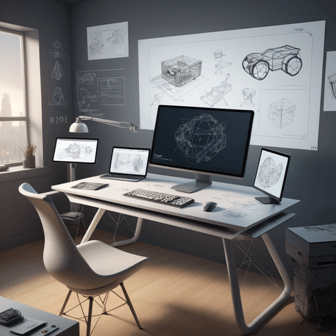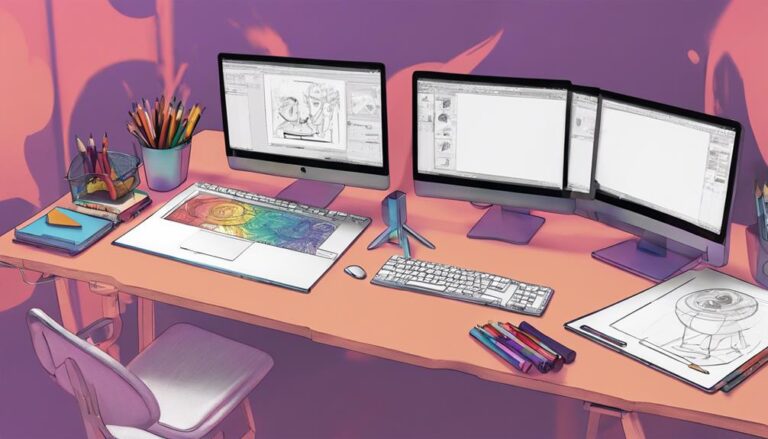5 Essential Principles for 3D Animation Videos
When creating a mesmerizing 3D animation video, you'll need to master five essential principles. You'll start by mastering storytelling in 3D, which involves crafting an immersive narrative with engaging characters and a well-structured plot. Next, you'll use effective lighting techniques to enhance the mood and atmosphere of each scene. You'll balance motion and texture to create visually stunning videos and control the visual flow by guiding the viewer's attention. Finally, you'll bring it all together by crafting engaging characters that resonate with your audience. Now, explore each principle to elevate your storytelling.
Key Takeaways
- Effective storytelling requires an engaging narrative structure with relatable characters, clear plot, and coherent storyline.
- A balanced lighting setup creates depth and dimension, evoking the desired mood and atmosphere in a scene.
- Harmonious motion and texture balance enhance visual appeal, prioritizing relevant textures and avoiding visual noise.
- Well-designed, relatable characters drive emotional resonance with authentic motivations, expressions, and body language.
- Controlling visual flow with a clear Visual Hierarchy guides the viewer's attention and enhances the overall impact of the animation.
Mastering Storytelling in 3D
One of the most essential elements in 3D animation videos is mastering storytelling in three dimensions. You're not just conveying a message; you're immersing your audience in a world that evokes emotions and sparks imagination.
To achieve this, you need to craft a narrative structure that's engaging, well-paced, and meaningful. This involves developing relatable characters, a clear plot, and a coherent storyline that flows logically.
As you build your narrative, focus on creating emotional resonance with your audience. This means making your characters' motivations, desires, and conflicts authentic and relatable.
Use visual storytelling techniques, such as camera angles, composition, and movement, to convey emotions and emphasize key moments in your story. A well-crafted narrative structure and emotional resonance will keep your audience invested in your story, making your 3D animation video more impactful and memorable.
Effective Use of Lighting
Lighting is a crucial element in 3D animation videos, as it can dramatically enhance the mood, atmosphere, and overall visual appeal of your scene.
When setting up your lighting, consider the lighting ratios that will help you achieve the desired effect. A common approach is to use a key light, fill light, and backlight to create depth and dimension in your scene.
The key light is the primary light source, while the fill light softens the shadows and the backlight separates your subject from the background.
To create a specific mood, you can experiment with different lighting setups and color temperatures.
For example, warm colors like orange and yellow can create a cozy atmosphere, while cool colors like blue and green can create a more somber mood.
When setting up your lighting, think about the mood you want to convey and adjust your lighting ratios accordingly.
By doing so, you can effectively use lighting to enhance the mood and atmosphere of your scene, drawing your audience in and engaging them with your story.
Effective lighting can make or break the overall impact of your 3D animation video.
Balancing Motion and Texture
As you explore into the world of 3D animation, balancing motion and texture becomes a crucial aspect of creating visually stunning videos.
You need to strike a balance between dynamic motion and intricate textures to captivate your audience. Motion harmony is key to achieving this balance – it involves carefully choreographing the movement of objects and characters to create a sense of fluidity and coherence.
When it comes to texture, establishing a clear hierarchy is essential.
You should prioritize textures that are most relevant to the scene and tone down others to avoid visual noise. This hierarchy should be informed by the story's context and the mood you want to convey. For instance, if you're creating a sci-fi animation, you may want to emphasize metallic textures to convey a sense of futurism.
Crafting Engaging Characters
Crafting engaging characters is often the most pivotal step in creating a compelling 3D animation video.
You'll want to focus on developing a character design that resonates with your audience. This involves creating a believable and relatable character that viewers can form an emotional connection with.
To achieve this, consider the character's personality, backstory, and motivations. What drives them? What're their strengths and weaknesses?
When designing your character, pay attention to proportions, facial expressions, and body language. These elements will help convey the character's emotions and personality traits.
You'll also want to guarantee that your character's design is consistent throughout the animation. This includes maintaining a consistent color palette, texture, and overall aesthetic.
Controlling the Visual Flow
Your 3D animation video's visual flow is the thread that weaves together its narrative, pacing, and emotional impact.
To control the visual flow effectively, you need to guide the viewer's attention through the scene. This is achieved by establishing a clear Visual Hierarchy, where the most important elements stand out from the rest.
You can create a Visual Hierarchy by using size, color, contrast, and placement to differentiate between elements.
Focal Points are also vital in controlling the visual flow. These are specific areas in the scene that draw the viewer's attention.
You can create Focal Points by using visual elements such as lines, shapes, and textures that lead the viewer's eye to a specific point. By carefully placing Focal Points, you can direct the viewer's attention to the most important elements in the scene.
Effective use of Visual Hierarchy and Focal Points enables you to create a clear and engaging visual flow that enhances the overall impact of your 3D animation video.
Frequently Asked Questions
What Software Is Best for Beginners in 3D Animation?
You're looking for 3D animation software as a beginner. Consider Blender, Maya, or 3ds Max, which offer free trials. Choose one that provides an intuitive user experience, allowing you to focus on learning and creating your best work.
How Long Does It Take to Create a 3D Animation Video?
When planning a 3D animation video, you'll determine its project timeline, factoring in your skill level, complexity, and budget constraints. It can take anywhere from a few weeks to several months or even years to complete, you'll set milestones accordingly.
Can I Use 3D Animation for Live-Action Film Projects?
You can seamlessly integrate 3D animation into live-action film projects, enhancing visual storytelling and elevating the cinematic experience. By combining CGI elements with live-action footage, you'll create a mesmerizing narrative that engages your audience.
What Is the Ideal Frame Rate for 3D Animation Videos?
You're likely aiming for a frame rate that optimizes smooth motion rendering. Typically, 24 or 30 frames per second is ideal for most 3D animation videos, but 60 FPS can be used for more intense or fast-paced scenes.
Are 3D Animation Skills Transferable to Video Game Design?
You'll find that 3D animation skills are highly transferable to video game design and game development, as they share similarities with virtual reality and interactive experiences, requiring strong storytelling, spatial reasoning, and visual effects expertise.
Conclusion
By incorporating these 5 essential principles, you'll elevate your 3D animation videos to the next level. Mastering storytelling sets the tone, while effective lighting and balanced motion and texture bring your world to life. Crafting engaging characters makes them relatable and memorable. Controlling the visual flow guides your audience through the narrative. Now, put these principles into practice to create immersive 3D animation videos that captivate and inspire your viewers.







